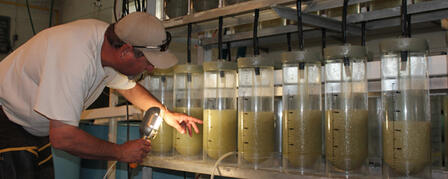KDWPT BIOLOGISTS LOOK TO CULTIVATE 80 MILLION WALLEYE EGGS

March 29, 2012
Early spring walleye spawning attracts fisheries biologists as well as anglers
PRATT — Historically, walleye were rare in Kansas, native to a few streams and rivers in the far eastern parts of a state with essentially no natural lakes. In the mid-20th century, however, lakes and reservoirs were built throughout the state, and the Kansas Fish and Game Commission (now the Department of Wildlife, Parks and Tourism, or KDWPT) began aggressively stocking walleye. Today, the walleye is an abundant prized sportfish and considered by many to be among the tastiest of all freshwater species in the Sunflower State.
But the fishery can’t be maintained without help. In late March and early April, walleye migrate to rocky shallows in Kansas reservoirs to spawn. KDWPT fisheries biologists take advantage of the spawn to harvest walleye eggs, which are then taken to agency hatcheries where increased hatching success means more fish for anglers in years to come.
This year, three reservoirs have provided KDWPT with walleye eggs. Egg-taking began on March 18 at Cedar Bluff Reservoir, March 20 at Hillsdale Reservoir, and March 23 at Milford Reservoir. Nets were placed to catch spawning females that provide eggs for both walleye and saugeye hatching programs. Fall test netting revealed large populations of big walleye in these three lakes.
Infestations of zebra mussels, white perch, and other aquatic nuisance species (ANS) in several Kansas reservoirs require special care during egg-taking to prevent the spread of these potentially-destructive species. All sperm and egg collection will take place on each lake and the fish returned to that lake immediately. Eggs are fertilized at the lake, as well, so no fish are moved.
On March 13, KDWPT biologists began catching male sauger and milking them for milt (sperm) for the saugeye hatching program. (The saugeye is a walleye/sauger hybrid.) Milt is preserved in vials that are taken to Milford Reservoir to fertilize walleye eggs.
Biologists will work for the next few weeks collecting and fertilizing eggs, transporting them to KDWPT's hatcheries at Farlington, Milford, and Pratt, and eventually stocking fish throughout the state. Some fry are stocked in hatchery ponds to be raised to fingerling size and stocked later in late May and early June. Others are stocked directly into lakes as fry.
In addition to walleye, the Milford Hatchery will produce the saugeye. Saugeye grow faster and larger than sauger and are thought to be less prone to wash-out high flow-through reservoirs than the walleye. To prevent production of fertile saugeye that have the potential to breed with walleye already in a lake — and potentially diluting that walleye population's genetics — a "triploid induction" process is used on some of the saugeye produced. Triploid induction is a technique that allows genetic manipulation of a chromosome number to create a potentially faster-growing, but sterile, saugeye.
KDWPT's statewide harvest goal for 2012 is 87 million eggs, with a production goal of 35 million walleye, eight million saugeye, and 1.2 million sauger. Because fewer than 5 percent of eggs hatch in the wild, artificial spawning and hatching is used to increase egg survival rates as much as 40-50 percent. When hatchery-bound eggs reach their destination, biologists monitor incubation closely. Water flows are checked to ensure constant but controlled movement. Water temperatures and oxygen content are also routinely checked. Dead eggs rise to the top of the jars and are siphoned off each day. With a water temperature of 60 degrees, hatching generally occurs on the eighth or ninth day of incubation. As the fry break out of their egg cases, they are carried upward by the water into large circular holding tanks where they are held for two to four days. Then they are ready for stocking.
All this activity may not be high-profile, but it makes Kansas walleye fishing much more productive. And as waters warm and days grow longer in late March and early April, many anglers take their cue from fisheries biologists and enjoy the opportunity to take walleye from the shore.
-30-







